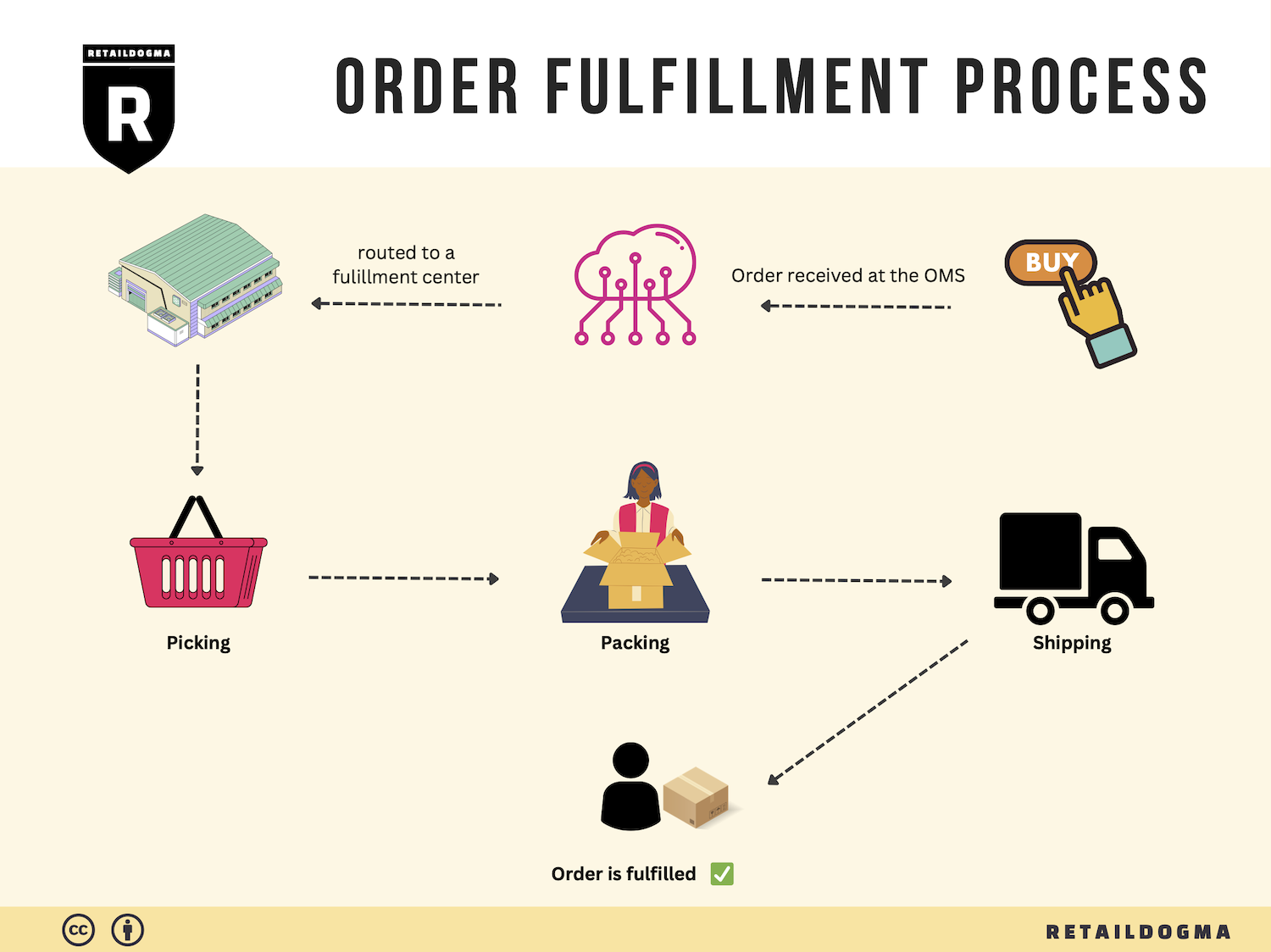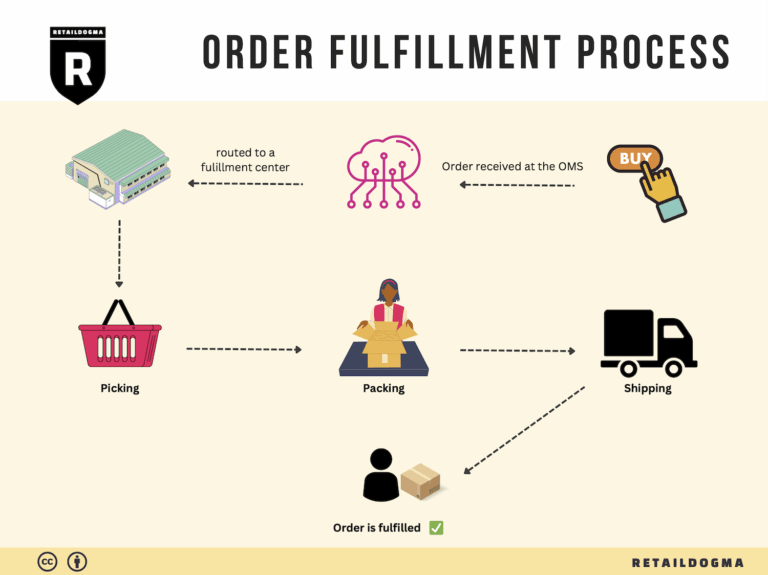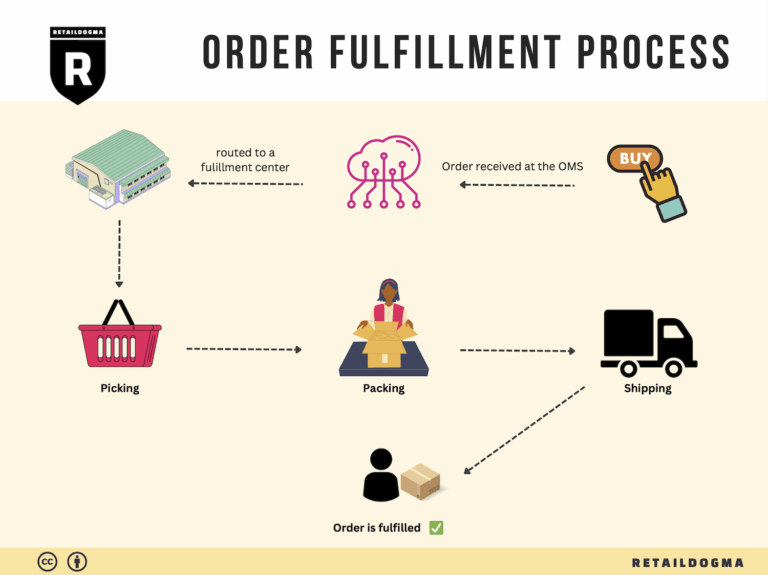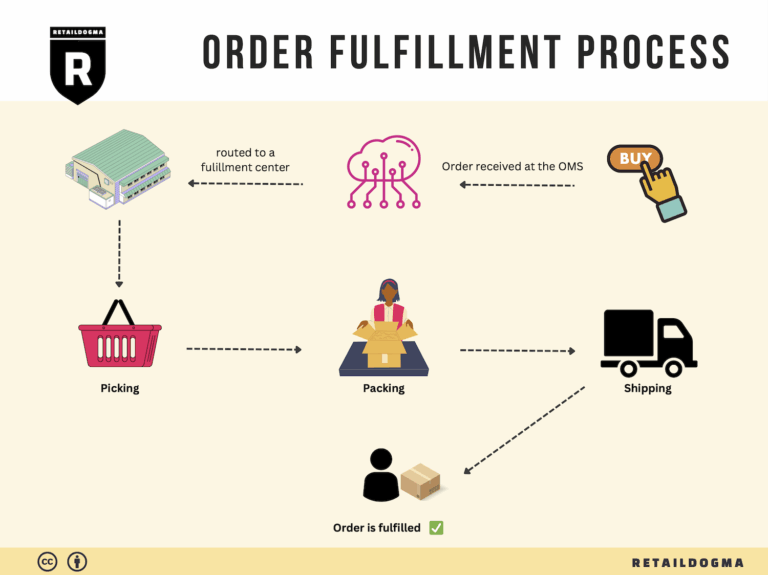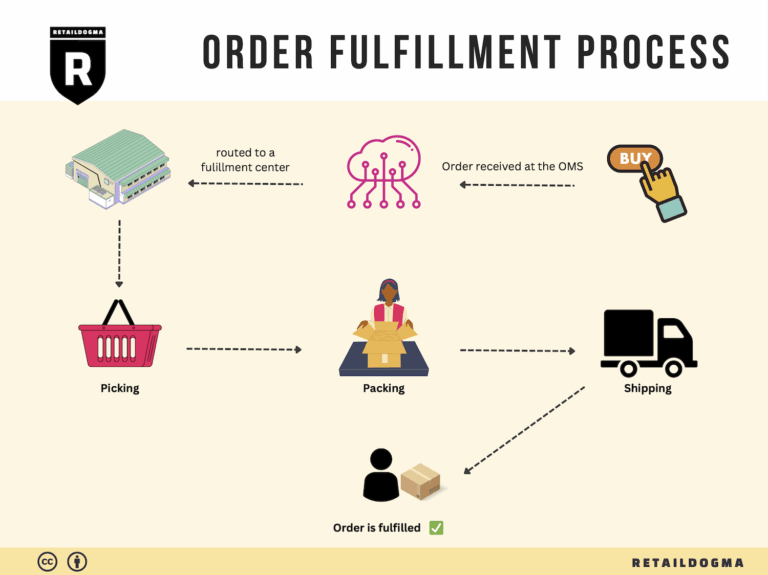How Order Fulfillment Works: A Step-by-Step Guide for Businesses
What is E-commerce Fulfillment? An Introduction for Growing Businesses
Understanding E-commerce Fulfillment: A Key to Scaling Your Business
As a growing online business owner, you may find yourself overwhelmed with the logistics of packing and shipping orders. The excitement of making sales can quickly turn into a headache when you realize the complexities involved in getting products to your customers efficiently. This is where e-commerce fulfillment comes into play. Simply put, fulfillment is the entire process of preparing and delivering a product to a customer, and it is crucial for maintaining customer satisfaction and operational efficiency.
Navigating the world of fulfillment can be daunting, especially when deciding between handling it in-house or outsourcing to a specialized service. This guide will provide a comprehensive overview of the different fulfillment models available to you, such as third-party logistics (3PL) and Fulfillment by Amazon (FBA). Understanding these options is essential for determining which approach aligns best with your business needs.
In addition to exploring fulfillment models, we will delve into the core services that make up a robust fulfillment operation. This includes warehousing, inventory management, order processing, logistics, and returns management. Each component plays a vital role in ensuring that your customers receive their orders promptly and accurately, which in turn can significantly affect your business’s reputation and growth.
Choosing the right fulfillment partner is another critical aspect we will cover. Factors such as scalability, technology integration, cost, and capabilities should be carefully considered when evaluating potential partners. Selecting a fulfillment service that aligns with your business’s needs can enhance your operational efficiency and free up your time to focus on growth strategies.
Finally, we will provide insights into pricing structures associated with fulfillment services. Understanding the cost breakdown, including setup fees, storage fees, and shipping costs, is essential for budgeting and maintaining healthy profit margins.
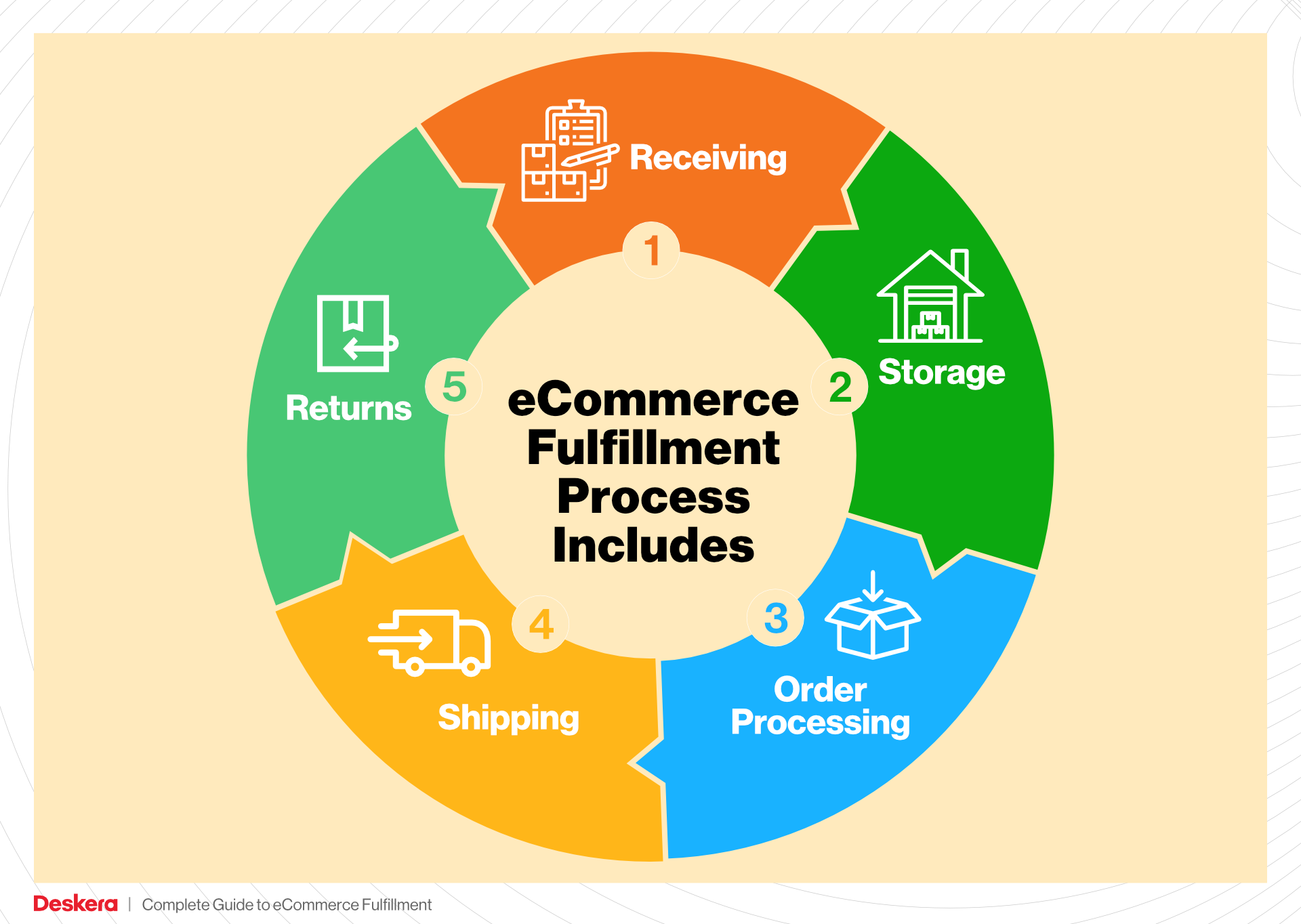
Our goal with this guide is to empower you, as a business owner, to make informed decisions about your logistics strategy. By understanding the ins and outs of e-commerce fulfillment, you can streamline your operations, improve customer satisfaction, and ultimately scale your business more effectively.
What You’ll Learn In This Guide
- What is E-commerce Fulfillment? An Introduction for Growing Businesses
- The Order Fulfillment Process: From ‘Buy’ Button to Customer’s Door
- Comparing Fulfillment Models: In-House vs. 3PL vs. Dropshipping
- A Deep Dive into Amazon FBA: Pros, Cons, and Who It’s For
- Core Services Offered by Fulfillment Centers
- How to Choose a Fulfillment Partner: A 6-Point Checklist
- Understanding Fulfillment Pricing: A Breakdown of Common Fees
- Frequently Asked Questions (FAQs) about Fulfillment
- Conclusion: Is Outsourcing Fulfillment the Right Move for Your Business?
- Important Disclaimer
The Order Fulfillment Process: From ‘Buy’ Button to Customer’s Door
1. Receiving Inventory
The order fulfillment process begins with receiving inventory from suppliers or manufacturers. This step is crucial as it sets the stage for how efficiently your fulfillment operations will run. Upon arrival, inventory is checked against the purchase order to ensure that the right quantities and types of products have been received. This process often involves the use of a Stock Keeping Unit (SKU), which is a unique identifier for each product variant, helping to streamline tracking and inventory management.
Properly receiving inventory not only ensures that you have the correct products on hand, but it also helps prevent future stockouts or overstock situations. Effective receiving processes can reduce errors and improve overall inventory accuracy, which is essential for maintaining customer satisfaction.
2. Warehouse Storage
Once inventory is received and verified, it is stored in a designated warehouse. This step involves organizing products in a way that maximizes space and improves picking efficiency. Efficient warehouse storage often employs bin locations, which designate specific areas for different products. This systematic approach allows warehouse staff to quickly locate items when orders come in.
The importance of effective warehouse storage cannot be overstated. A well-organized warehouse reduces the time taken to find products, minimizing delays in order fulfillment. Additionally, implementing inventory management systems that track stock levels and locations in real-time can help avoid stock discrepancies and ensure that you always know what is available for sale.
3. Order Picking
When a customer places an order, the next step in the fulfillment process is order picking. This involves retrieving the ordered items from their respective storage locations in the warehouse. To enhance efficiency, warehouses often utilize pick lists, which are lists that outline the items needed for each order, including their locations.
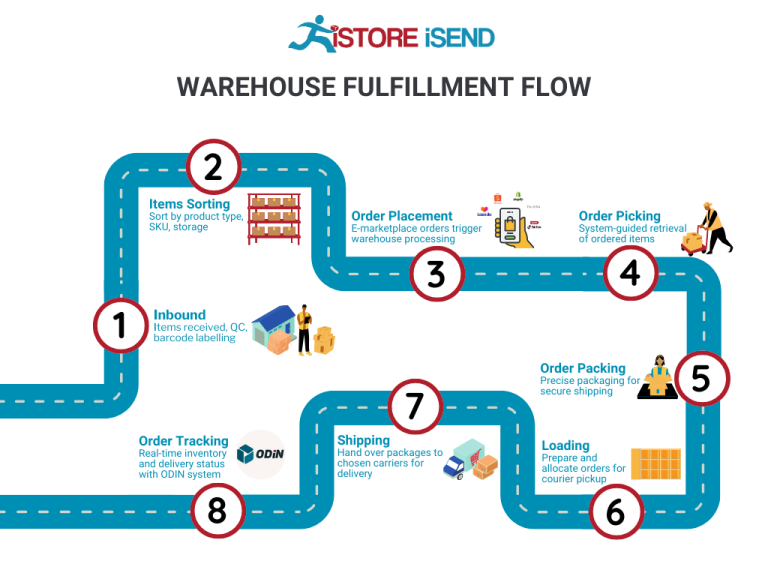
Order picking is a critical phase because it directly affects the speed and accuracy of order fulfillment. Errors in this step can lead to incorrect shipments, which can harm customer satisfaction and increase return rates. By employing methods like batch picking (picking multiple orders at once) or zone picking (assigning specific areas of the warehouse to individual pickers), businesses can optimize their picking process and reduce the time it takes to get orders ready for packing.
4. Order Packing
After the items have been picked, they are moved to the packing station. In this step, products are carefully packed into boxes or envelopes, ensuring they are secure for transit. The packing process often involves generating packing slips, which include details about the order and serve as a receipt for the customer.
Effective packing is vital for preventing damage during shipping and ensuring that customers receive exactly what they ordered. Using appropriate packaging materials and methods can significantly reduce the risk of returns due to damaged items. Additionally, a well-organized packing station can speed up the packing process, allowing for quicker turnaround times on shipments, which is critical for maintaining competitive delivery speeds.
5. Shipping & Delivery
The final step in the order fulfillment process is shipping and delivery. Once the order is packed, it is labeled and handed over to a shipping carrier, such as FedEx or UPS. This stage often utilizes a shipping management system to select the most efficient shipping method based on factors like cost, speed, and destination.
Shipping and delivery are perhaps the most visible aspects of the fulfillment process to the customer, making them incredibly important for customer satisfaction. Timely and accurate delivery can foster customer loyalty and encourage repeat business. Businesses should also provide tracking information to customers, allowing them to monitor their orders in real time, which enhances the overall customer experience.
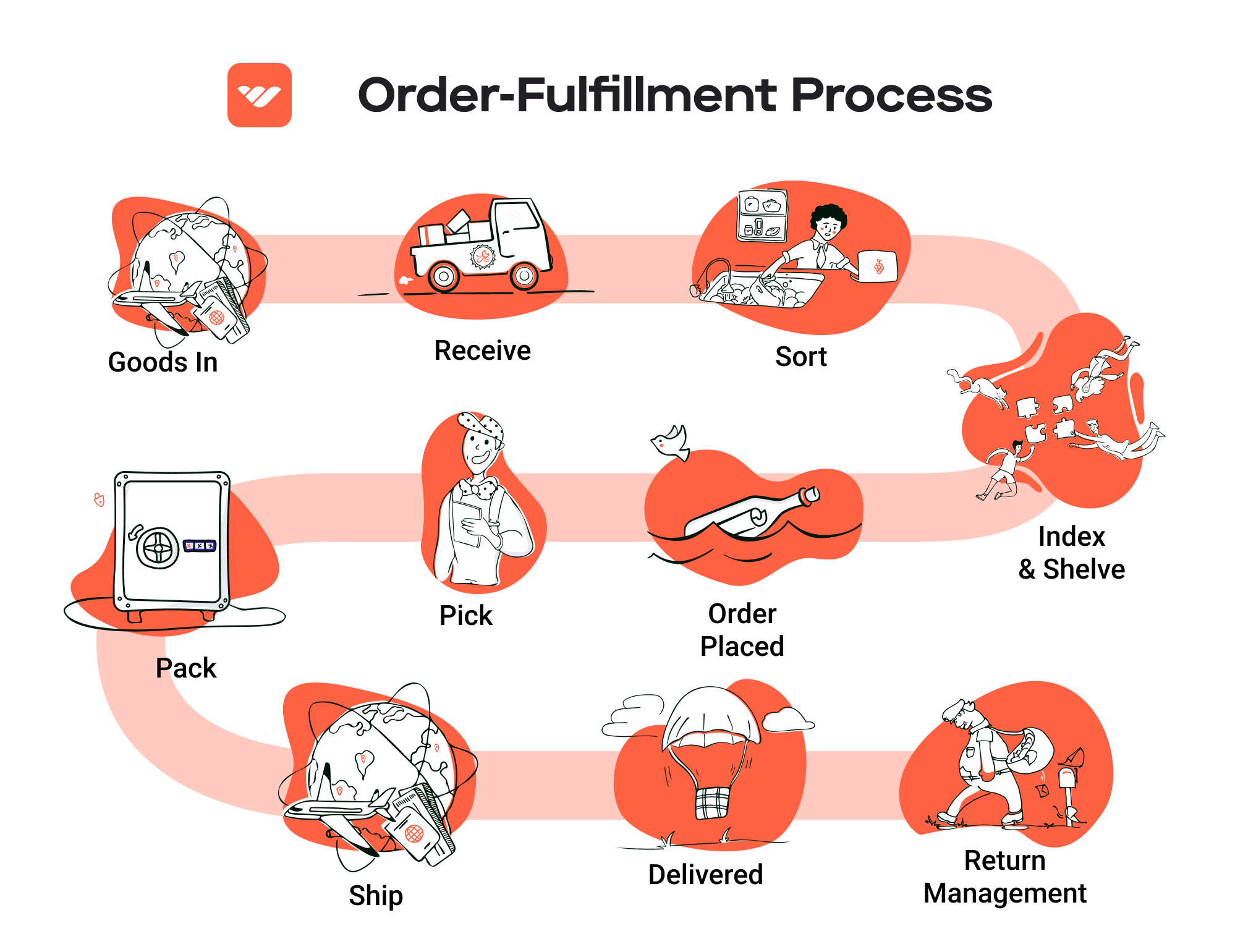
In summary, understanding and optimizing each step of the order fulfillment process—from receiving inventory to shipping and delivery—can significantly impact your e-commerce business’s efficiency and customer satisfaction. By focusing on these key components, you can create a streamlined fulfillment operation that supports your growth and scaling efforts.
Comparing Fulfillment Models: In-House vs. 3PL vs. Dropshipping
Comparison of Fulfillment Models
| Model | Who Handles Inventory | Best For (Business Stage) | Key Advantage | Key Disadvantage |
|---|---|---|---|---|
| In-House Fulfillment | The business itself | Startups and small businesses | Control over processes and quality | Resource-intensive and costly |
| Third-Party Logistics (3PL) | A specialized logistics provider | Growing businesses with scalability needs | Professional expertise and scalability | Less control over inventory and processes |
| Dropshipping | Supplier or manufacturer | Entrepreneurs and low-capital startups | Low overhead costs | Limited control and potential quality issues |
In-House Fulfillment
In-house fulfillment refers to a model where the e-commerce business manages all aspects of order fulfillment internally. This includes the storage of inventory, picking, packing, shipping, and customer notifications. For startups and smaller businesses that are just beginning to establish their brand, in-house fulfillment can offer an appealing advantage: complete control over the entire process. This allows for personalized packaging, quality assurance, and direct oversight of the inventory. Additionally, businesses can better respond to customer inquiries regarding order status and product availability. However, this model is resource-intensive. It requires significant investments in warehousing space, technology for inventory management, and labor costs associated with packing and shipping. As the business scales, maintaining efficiency can become challenging, particularly during peak seasons or promotional events, where order volumes may surge unexpectedly.
Third-Party Logistics (3PL)
Third-party logistics (3PL) involves outsourcing fulfillment operations to a specialized logistics provider. This model is especially advantageous for growing businesses that need to scale quickly without the burden of managing logistics in-house. A 3PL provider typically handles warehousing, inventory management, order processing, and shipping, allowing businesses to focus on core operations like marketing and product development. The professional expertise of a 3PL can streamline processes and improve efficiency, which is crucial for businesses experiencing rapid growth or fluctuations in demand. Moreover, many 3PLs offer integrated technology solutions that sync with e-commerce platforms, providing real-time inventory tracking and order updates. However, the trade-off for this convenience is a loss of control over inventory management and fulfillment processes. Businesses may face challenges in ensuring that their specific standards of quality and customer experience are met, particularly if their 3PL partner does not prioritize these aspects.
Dropshipping
Dropshipping is a fulfillment model where the e-commerce store does not hold any inventory. Instead, when a customer places an order, the store purchases the item from a third-party supplier who then ships it directly to the customer. This model is particularly suitable for entrepreneurs or businesses with limited capital as it eliminates the need for inventory investment and storage costs. Since fulfillment is handled by the supplier, businesses can offer a wide range of products without the risk of overstocking or managing logistics. Additionally, dropshipping allows for flexibility and scalability, as businesses can adjust their product offerings based on customer demand without significant overhead. However, the major downside is the lack of control over product quality, shipping times, and customer experience. If a supplier fails to meet shipping deadlines or delivers subpar products, it can reflect poorly on the e-commerce business, potentially harming customer relationships and brand reputation. Furthermore, profit margins may be lower due to the costs associated with relying on a third-party supplier.
Conclusion
Each fulfillment model presents distinct advantages and challenges that can significantly impact an e-commerce business’s operational efficiency and customer satisfaction. In-house fulfillment offers control and quality assurance, making it ideal for smaller businesses, while 3PL services provide scalability and professional logistics management for growing businesses. Dropshipping, on the other hand, is a low-cost entry point for new entrepreneurs but comes with the risks of lower quality control and customer service challenges. Understanding these nuances is crucial for e-commerce business owners and operations managers as they make informed decisions to scale their logistics effectively.
A Deep Dive into Amazon FBA: Pros, Cons, and Who It’s For
Understanding Fulfillment by Amazon (FBA)
Fulfillment by Amazon (FBA) is a service that allows e-commerce sellers to store their products in Amazon’s fulfillment centers. Amazon then takes care of storage, packaging, and shipping products directly to customers. This service enables sellers to leverage Amazon’s vast logistics network, allowing them to focus on growing their business while Amazon manages the order fulfillment process.
How FBA Works
-
Product Setup: Sellers begin by creating a seller account on Amazon and listing their products. They decide which products they want to fulfill through FBA.
-
Shipping Inventory: Once products are listed, sellers ship their inventory to Amazon’s fulfillment centers. Amazon provides guidelines on how to package and label products for shipment.
-
Storage: After the inventory arrives at the fulfillment center, Amazon stores the products until an order is placed.
-
Order Processing: When a customer places an order, Amazon picks, packs, and ships the product on behalf of the seller. They also handle customer service and returns.
-
Tracking and Reporting: Sellers can monitor their inventory levels and sales through the Amazon Seller Central dashboard, which provides insights and analytics to help manage their business.
Pros of Using FBA
1. Prime Eligibility
FBA products automatically qualify for Amazon Prime, which gives sellers access to millions of Prime customers who prefer fast and free shipping. This can significantly increase sales, as many customers filter their searches to show only Prime-eligible items.
2. Enhanced Customer Trust
Amazon is a trusted name in e-commerce. By using FBA, sellers benefit from Amazon’s reputation, which can lead to higher conversion rates. Customers are more likely to purchase products fulfilled by Amazon due to the assurance of reliable shipping and excellent customer service.
3. Multi-Channel Fulfillment
FBA isn’t limited to Amazon sales. Sellers can use FBA to fulfill orders from other sales channels, such as their own websites or eBay. This multi-channel fulfillment capability allows businesses to streamline operations and manage inventory more efficiently.
4. Scalability
FBA allows sellers to scale their business without worrying about the logistics of order fulfillment. As sales increase, sellers can simply send more inventory to Amazon’s fulfillment centers, leaving the logistics to Amazon.
5. Customer Service and Returns Handling
Amazon handles customer inquiries, complaints, and returns on behalf of sellers. This can save significant time and resources for sellers, allowing them to focus on other aspects of their business.
Cons of Using FBA
1. High Fees
While FBA provides many benefits, it comes with costs that can cut into profit margins. Sellers incur storage fees for keeping their inventory in Amazon’s warehouses, as well as fulfillment fees for each item sold. These costs can add up, especially for sellers with low-margin products.
2. Strict Inventory Rules
Amazon has specific guidelines regarding inventory management. Sellers must adhere to strict policies regarding storage limits and product preparation. Failure to comply can result in penalties or even suspension of selling privileges.
3. Commingling Risks
FBA uses a process called commingling, where inventory from multiple sellers may be stored together. This can pose risks if items are damaged or if customers receive products that are not from the original seller. Issues with commingled inventory can lead to disputes and customer dissatisfaction.
4. Loss of Control
When using FBA, sellers relinquish control over the fulfillment process. This can be a disadvantage for those who prefer to maintain oversight of how their products are handled, packaged, and shipped.
5. Inventory Management Challenges
Managing inventory levels can be challenging with FBA. Sellers must accurately predict demand to avoid excess storage fees or stockouts, which can lead to lost sales.
Who is FBA Best For?
FBA is particularly well-suited for:
-
Small to Medium-Sized Businesses: Companies looking to scale quickly without investing in their own logistics infrastructure can benefit significantly from FBA. It allows them to reach a larger audience without the overhead costs associated with warehousing and shipping.
-
Sellers with High Volume: Businesses that expect to sell a high volume of products can leverage FBA to handle the logistics efficiently. The economies of scale can help offset the fees associated with the service.
-
E-commerce Entrepreneurs: Startups and entrepreneurs who want to focus on product development, marketing, and customer acquisition rather than logistics will find FBA a valuable resource.
-
Sellers with Diverse Inventory: Businesses that sell a wide range of products can take advantage of Amazon’s fulfillment capabilities, allowing them to manage multiple SKUs without the complexities of in-house fulfillment.
In conclusion, while Fulfillment by Amazon offers numerous advantages, it is essential for sellers to evaluate the associated costs and challenges. Understanding the nuances of FBA can help e-commerce business owners make informed decisions that align with their operational goals and growth strategies.
Core Services Offered by Fulfillment Centers
Inventory Management & Warehousing
Inventory management and warehousing are foundational elements of any fulfillment operation. Fulfillment centers provide businesses with the necessary space to store products securely and efficiently. This service includes tracking inventory levels, managing stock locations, and overseeing the inflow and outflow of goods. Advanced inventory management systems integrate seamlessly with e-commerce platforms to provide real-time visibility of stock levels, ensuring that businesses can react quickly to demand fluctuations.
Benefits:
1. Space Optimization: By utilizing a fulfillment center’s storage facilities, e-commerce businesses can free up their own premises for other purposes, such as product development or customer service.
2. Reduced Overheads: Outsourcing warehousing can significantly reduce costs associated with maintaining a physical storage space, including rent, utilities, and staffing.
3. Improved Accuracy: Automated inventory management minimizes the risk of human error, ensuring that stock levels are accurately maintained and reducing the likelihood of stockouts or overstock situations.
4. Scalability: Fulfillment centers allow businesses to scale operations without the need for large capital investments in additional warehouse space or inventory management technology.
Pick and Pack Services
Pick and pack services refer to the process of selecting items from storage based on customer orders and packing them for shipment. Fulfillment centers employ trained staff and utilize specialized technology to streamline this process, ensuring that orders are fulfilled accurately and efficiently. This service typically involves receiving orders, picking the correct items, packing them securely, and preparing them for shipment.
Benefits:
1. Speed and Efficiency: Fulfillment centers specialize in order processing, which means they can pick and pack items more quickly than most in-house operations. This leads to faster shipping times and improved customer satisfaction.
2. Error Reduction: With experienced staff and automated systems, fulfillment centers minimize picking errors, ensuring that customers receive the correct items and reducing the need for returns.
3. Labor Cost Savings: By outsourcing pick and pack services, businesses can save on labor costs associated with hiring, training, and managing warehouse staff.
4. Focus on Core Business: By delegating the pick and pack process to a fulfillment center, e-commerce businesses can concentrate on their core competencies, such as marketing and product development, rather than day-to-day logistics.
Kitting and Assembly
Kitting and assembly services involve combining multiple products into a single package or preparing items for sale. This can include assembling products, creating gift bundles, or packaging items in a specific configuration. Fulfillment centers that offer kitting and assembly services can help e-commerce businesses create unique product offerings or promotional bundles that appeal to customers.
Benefits:
1. Customization: Businesses can create tailored product offerings that meet specific customer needs or seasonal demands, enhancing their market appeal.
2. Streamlined Processes: By outsourcing kitting and assembly to a fulfillment center, e-commerce businesses can streamline their operations and reduce the complexity of managing multiple SKUs.
3. Enhanced Customer Experience: Offering customized bundles or assembled products can improve customer satisfaction and encourage repeat purchases, as customers appreciate the convenience and thoughtfulness of bundled offerings.
4. Cost Efficiency: Fulfillment centers often have the resources and expertise to perform kitting and assembly at a lower cost than businesses would incur if they managed these processes in-house.
Returns Management (Reverse Logistics)
Returns management, also known as reverse logistics, is an essential service offered by fulfillment centers that deals with the process of handling returns from customers. This includes receiving returned items, inspecting them for quality, restocking them if applicable, and processing refunds or exchanges. A robust returns management system is crucial for maintaining customer satisfaction and loyalty.
Benefits:
1. Improved Customer Trust: Efficient handling of returns enhances customer confidence in the business, knowing that they can easily return products if they are unsatisfied.
2. Cost Savings: Fulfillment centers often have streamlined processes for handling returns, which can reduce the overall costs associated with managing returns in-house.
3. Inventory Replenishment: With effective returns management, businesses can quickly restock returned items, ensuring that inventory levels are maintained and ready for resale.
4. Data Insights: Analyzing returns data can provide valuable insights into product performance, allowing businesses to make informed decisions regarding inventory management and product offerings.
In summary, leveraging the core services of fulfillment centers can significantly enhance an e-commerce business’s efficiency, scalability, and customer satisfaction. By outsourcing key logistics functions, businesses can focus on growth and innovation while ensuring that their fulfillment processes run smoothly and effectively.
How to Choose a Fulfillment Partner: A 6-Point Checklist
Location & Warehouse Network
Importance:
The geographical location of your fulfillment partner’s warehouses is crucial for optimizing shipping costs and delivery times. A partner with strategically located warehouses can help you reach your customers faster and reduce shipping expenses, which is especially important for maintaining a competitive edge in e-commerce.
Questions to Ask:
– Where are your warehouses located, and how many do you operate?
– Can you provide shipping time estimates to my primary customer locations?
– Do you have a network of warehouses that can facilitate multi-channel distribution?
– How do you manage inventory across multiple locations?
Technology & Integrations
Importance:
A fulfillment partner’s technology infrastructure can significantly impact the efficiency of your operations. Look for partners that offer seamless integrations with your existing e-commerce platforms, inventory management systems, and other software tools. This can help minimize errors and streamline order processing.
Questions to Ask:
– What technology platform do you use for order fulfillment?
– Can your system integrate with my current e-commerce platform (e.g., Shopify, WooCommerce)?
– How do you handle inventory management and real-time updates?
– Do you offer tracking capabilities for both orders and inventory?
Specializations (e.g., Cold Storage, Oversized Items)
Importance:
Different businesses have unique product requirements. If you sell perishable goods, fragile items, or oversized products, it’s essential to partner with a fulfillment service that specializes in handling those specific needs. This ensures that your products are stored and shipped appropriately, maintaining quality and customer satisfaction.
Questions to Ask:
– What types of products do you specialize in fulfilling?
– Do you have facilities for cold storage or handling hazardous materials?
– Are there any limitations on the size or weight of products you can fulfill?
– How do you ensure the safe packaging and handling of fragile items?
Scalability & Capacity
Importance:
As your business grows, your fulfillment needs will evolve. Your partner should be able to scale operations up or down based on demand fluctuations, whether from seasonal spikes or unexpected growth. A partner that can accommodate your changing needs without compromising service quality is invaluable.
Questions to Ask:
– How do you handle peak seasons or unexpected surges in order volume?
– Can you provide examples of how you’ve scaled for other clients?
– What is your current capacity, and how do you plan to expand in the future?
– How quickly can you onboard additional inventory if I need to increase stock?
Pricing and Contracts
Importance:
Understanding the pricing structure of your fulfillment partner is critical for maintaining healthy profit margins. Different partners have varying pricing models, including setup fees, storage fees, and shipping costs. Ensure you have a clear understanding of all potential charges before signing a contract.
Questions to Ask:
– Can you provide a detailed breakdown of your pricing structure?
– Are there any hidden fees I should be aware of (e.g., minimum monthly fees, additional charges for peak seasons)?
– How do you handle pricing for shipping, and do you offer discounts with certain carriers?
– What is the length of the contract, and what are the terms for termination or renegotiation?
Customer Support & Reviews
Importance:
Reliable customer support is essential in the fulfillment process. Issues can arise at any time, and having a responsive support team can help resolve problems quickly, ensuring minimal disruption to your operations. Additionally, looking at reviews and testimonials can provide insight into the partner’s reliability and service quality.
Questions to Ask:
– What kind of customer support do you offer (e.g., phone, email, chat)?
– What are your support team’s hours of operation?
– Can you provide references or case studies from current clients?
– How do you handle issues such as order discrepancies or shipping delays?
Conclusion
Choosing the right fulfillment partner is a critical decision that can significantly impact your e-commerce business’s success. By carefully evaluating potential partners using this checklist, you can ensure that you select a fulfillment service that aligns with your operational needs, enhances customer satisfaction, and supports your growth objectives. Prioritize clear communication and thorough due diligence to forge a partnership that not only meets your immediate needs but also scales with your business over time.
Understanding Fulfillment Pricing: A Breakdown of Common Fees
Initial Setup Fees
Initial setup fees are often the first expense you’ll encounter when partnering with a fulfillment service. These fees cover the costs associated with integrating your existing systems with the fulfillment provider’s platform. This process typically includes syncing your inventory data, establishing the logistics flow, and setting up any necessary software connections.
The calculation of initial setup fees can vary significantly based on the complexity of your operations and the provider’s technology. Some providers may charge a flat fee, while others may base their pricing on the time required for the setup process. Be sure to ask about potential hidden costs, such as additional charges for training your team to use the new system.
Receiving Fees
Receiving fees are charged when your inventory arrives at the fulfillment center. This fee covers the labor costs associated with unloading, inspecting, and organizing incoming shipments. It ensures that your products are properly accounted for and stored in the warehouse.
Typically, receiving fees are calculated on a per-pallet or per-box basis. For example, a fulfillment center might charge a standard rate for each pallet of goods they receive. If your products arrive in various box sizes, the provider may have different fee structures based on the volume or weight of the items. It’s essential to clarify these rates upfront, especially if your product shipments vary in size and frequency.
Storage Fees (per pallet/bin)
Storage fees are recurring charges for keeping your products in the fulfillment center. This fee is generally calculated on a monthly basis and is often based on the amount of space your inventory occupies, measured in pallets or cubic feet.
For instance, a fulfillment center may charge a fixed monthly rate per pallet or a cubic foot of storage space used. It’s crucial to understand the storage fee structure, especially if you anticipate fluctuations in inventory levels. Providers may also have tiered pricing, where the cost per pallet decreases as you store more, so it’s beneficial to negotiate based on your expected storage needs.
Pick & Pack Fees (per item/order)
Pick and pack fees are incurred each time an order is processed. This fee covers the labor involved in picking items from storage, packing them securely, and preparing them for shipment. Pick and pack fees can vary widely among fulfillment providers, depending on factors such as the number of items per order and the complexity of the packing process.
Most fulfillment centers calculate these fees on a per-item or per-order basis. For example, they may charge a flat fee for the first item and an additional fee for each subsequent item. Be sure to inquire about any minimum order fees or discounts for larger orders, as these can impact your overall fulfillment costs significantly.
Shipping Fees
Shipping fees are one of the most variable costs in the fulfillment process and are typically based on the weight and dimensions of the package, the shipping method selected, and the destination. Fulfillment centers often partner with major carriers, allowing them to negotiate better shipping rates, which can be passed on to you.
When evaluating shipping fees, consider the different options available, such as standard, expedited, or international shipping. Some providers may offer flat-rate shipping, while others calculate costs dynamically based on real-time carrier rates. Understanding these fee structures can help you choose the most cost-effective shipping methods for your business.
Tips for Getting an Accurate Quote
-
Be Transparent About Your Needs: Provide potential fulfillment partners with detailed information about your product types, order volumes, and shipping requirements. This transparency helps them give you a more accurate quote.
-
Ask for a Breakdown: Request a detailed breakdown of all fees associated with the fulfillment process. This will allow you to compare different providers more effectively and avoid unexpected costs.
-
Consider Seasonal Variations: If your business experiences seasonal spikes in order volume, discuss how this will affect storage and shipping fees with potential partners.
-
Negotiate Terms: Don’t hesitate to negotiate terms and fees. Many fulfillment providers are open to customizing pricing based on your specific needs and can offer discounts for higher volumes.
-
Review Contractual Obligations: Before signing any agreements, thoroughly review the contractual obligations, including minimum monthly requirements and any potential penalties for underperformance.
By understanding these common fulfillment pricing models and following these tips, you can make informed decisions that will help you scale your e-commerce business effectively while managing costs.
Frequently Asked Questions (FAQs) about Fulfillment
1. What is fulfillment in e-commerce?
Fulfillment in e-commerce refers to the process of receiving, processing, and delivering customer orders. This encompasses everything from inventory management, order processing, packing, and shipping, to handling returns. Effective fulfillment is crucial for customer satisfaction and operational efficiency.
2. What’s the difference between a warehouse and a fulfillment center?
A warehouse primarily serves as a storage facility for products, focusing on inventory management. In contrast, a fulfillment center is specifically designed to handle the entire order fulfillment process, including picking, packing, and shipping products directly to customers. Fulfillment centers often utilize technology to streamline operations and enhance customer service.
3. What is a 3PL (Third-Party Logistics)?
A 3PL, or Third-Party Logistics provider, is a company that offers outsourced logistics services to businesses. This includes warehousing, inventory management, order fulfillment, and shipping. Partnering with a 3PL allows businesses to focus on their core operations while leveraging the expertise and resources of a logistics specialist.
4. How much do fulfillment services cost?
Fulfillment service costs can vary widely based on several factors, including the provider’s pricing structure, the volume of orders, the size and weight of products, and additional services offered. Typical cost components include setup fees, storage fees, receiving fees, picking and packing fees, and shipping fees. It’s essential to get a detailed quote and understand all potential charges before committing to a fulfillment partner.
5. What are the benefits of outsourcing fulfillment?
Outsourcing fulfillment can lead to increased efficiency, reduced overhead costs, and improved scalability. It allows businesses to focus on growth and customer service rather than the logistics of storage and shipping. Additionally, fulfillment providers often have established relationships with shipping carriers, which can lead to better rates and faster delivery times.
6. How does the fulfillment process work?
The fulfillment process typically involves several key steps:
1. Order Receipt: Orders are received through the e-commerce platform.
2. Inventory Check: The system checks inventory levels to ensure the items are available.
3. Picking: Warehouse staff pick the items from storage.
4. Packing: Items are packed securely for shipping.
5. Shipping: The packed order is shipped to the customer using a chosen carrier.
6. Delivery Confirmation: The customer receives notification that their order is on its way, and delivery is confirmed.
7. What technology is used in fulfillment operations?
Fulfillment operations often utilize various technologies, including warehouse management systems (WMS), inventory management systems, and order processing software. These technologies help track inventory levels, manage orders, optimize shipping routes, and provide real-time updates on order status, which enhances operational efficiency and customer satisfaction.
8. Can I handle fulfillment in-house?
Yes, businesses can choose to handle fulfillment in-house, especially if they have the resources and infrastructure. This involves managing storage, staffing, and logistics directly. However, in-house fulfillment can be resource-intensive and may not be scalable, particularly during peak seasons or rapid growth periods.
9. What are the challenges of fulfillment?
Common challenges in fulfillment include managing inventory levels, ensuring timely delivery, handling returns efficiently, and maintaining quality control. Additionally, businesses may face difficulties in scaling their operations to meet sudden increases in demand, which can lead to delays and customer dissatisfaction.
10. What is dropshipping, and how does it relate to fulfillment?
Dropshipping is a fulfillment model where the retailer does not hold inventory. Instead, when a customer places an order, the retailer purchases the item from a third-party supplier, who then ships it directly to the customer. This model reduces overhead costs and allows businesses to offer a wider range of products without the need for inventory storage, but it can limit control over shipping times and product quality.
Conclusion: Is Outsourcing Fulfillment the Right Move for Your Business?
Evaluating the Benefits of Outsourcing Fulfillment
Outsourcing fulfillment can be a transformative decision for e-commerce businesses looking to scale effectively. One of the most significant benefits is the time saved by delegating order processing, packing, and shipping to a specialized fulfillment service. This allows business owners and their teams to focus on strategic initiatives such as marketing, product development, and customer engagement, rather than getting bogged down by logistics.
Another advantage is scalability. As your business grows, so does the complexity of managing inventory and fulfilling orders. A fulfillment partner can adapt to fluctuations in demand, ensuring that you can meet customer expectations without the need for significant upfront investment in warehousing and logistics infrastructure. This flexibility not only supports growth but also enhances customer satisfaction through consistent and timely deliveries.
Moreover, outsourcing fulfillment brings in expertise. Fulfillment companies are equipped with the latest technology and industry best practices, allowing them to streamline processes and minimize errors. By leveraging their knowledge, you can improve your operational efficiency and reduce costs associated with shipping and inventory management.
However, the success of outsourcing hinges on choosing the right fulfillment partner. It’s essential to assess potential providers based on their capabilities, technology integration, and alignment with your business needs. A misaligned partnership can lead to inefficiencies and customer dissatisfaction, undermining the benefits of outsourcing.
Take Action
Now is the time to evaluate your current fulfillment processes. Conduct an audit of your shipping operations to identify pain points and areas for improvement. Consider whether partnering with a fulfillment service could enhance your efficiency and support your growth ambitions. By strategically assessing your options, you can make an informed decision that positions your business for success in the competitive e-commerce landscape.
Important Disclaimer
⚠️ Important Disclaimer
The information in this guide is for educational purposes. Fulfillment services, pricing, and platform features change frequently. Always conduct your own due diligence and consult with providers directly before making business decisions.
